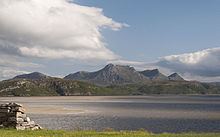Bridges Kyle of Tongue Bridge | ||
 | ||
The Kyle of Tongue (Scottish Gaelic: Caol Thunga) is a shallow sea loch in northwest Highland, Scotland, in the western part of the former county of Sutherland. Featuring a rocky coastline, its mouth is formed at Tongue Bay. The community of Tongue is situated on the Kyle's eastern shore and the loch is crossed by the Kyle of Tongue Bridge and Causeway. Nearby are Ben Hope and Ben Loyal.
Contents
Map of Kyle of Tongue, United Kingdom
History
According to the Origines Parochiales Scotiae, Castle Varrich, an old square tower on a hill on the east side of the Kyle, was the residence of Karl Hundason, who made an effort to conquer Scotland on the death of Malcolm II. There are three brochs: on the Kyle's east side opposite Melness; at the head of the Kyle; and at Dunbuie, a hill on the west side of the Kyle.
In 1746, a naval engagement occurred at the Kyle involving Bonnie Prince Charlie's Jacobite rebellion. The Jacobite ship Le Prince Charles, commanded by Captain Richard Talbot, was bringing a large amount of French gold to aid the Jacobite cause. It was chased by a British squadron and one of the Royal Navy frigates eventually caught up with it in the Kyle of Tongue, on 25 February 1746. A fierce five-hour battle took place: the Jacobite ship fought bravely, but in the end was defeated. The failure of the gold to reach the Prince’s army was one of the main factors which led to the Battle of Culloden.
Geography
Kyle of Tongue is situated 8 miles (13 km) east of Loch Eriboll. Its western entrance is between Cnoc Glass and Roan Island; the eastern entrance is between Rosin Island and Neave Island. From Roan Island, the kyle trends in a south and southwest direction for 7 miles (11 km) to Kinloch. A large portion of it is sandy, with a narrow bar-encumbered channel running through it. The depths range from approximately 18 fathoms west of Roan Island to 5 fathoms in the area 1.5 miles (2.4 km) above where the shallows begin. There is no channel into the Kyle of Tongue along the western shore. Derry (or Loch an Dithreibh) is a lake which empties into the head of the Kyle of Tongue. Strathtongue, a 8 miles (13 km) long stream, runs to the Kyle.
Flora and fauna
The surrounding hills are characterized by meadows, grasses, and heath. There is moorland between the Kyle and Loch Eriboll.
Water fauna within the Kyle include salmon and sea trout, while whales and otters are at the mouth. Avifauna include Barn Swallow, Black-headed Gull, Common Raven, Common Redshank, Common Wood-Pigeon, European Herring Gull, Eurasian Collared-Dove, Eurasian Curlew, Eurasian Oystercatcher, Eurasian Golden-Plover, Great Black-backed Gull, Great Cormorant, Grey Heron, Greylag Goose, House Martin, House Sparrow, Meadow Pipit, Mew Gull, Red-throated Loon, and Rock Pigeon.
